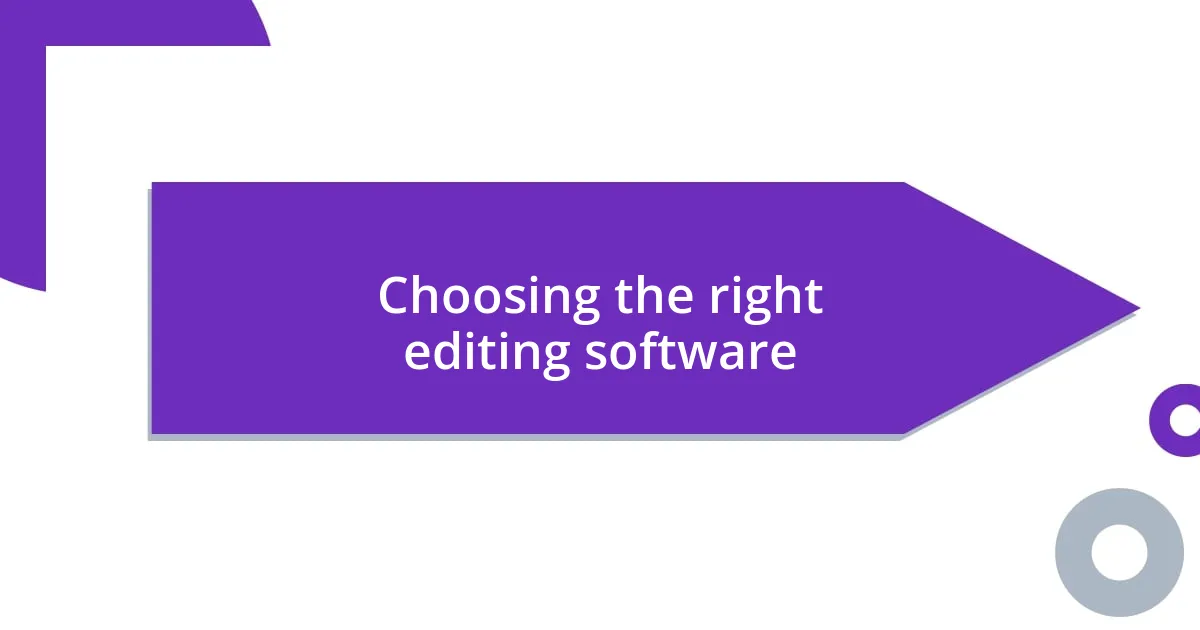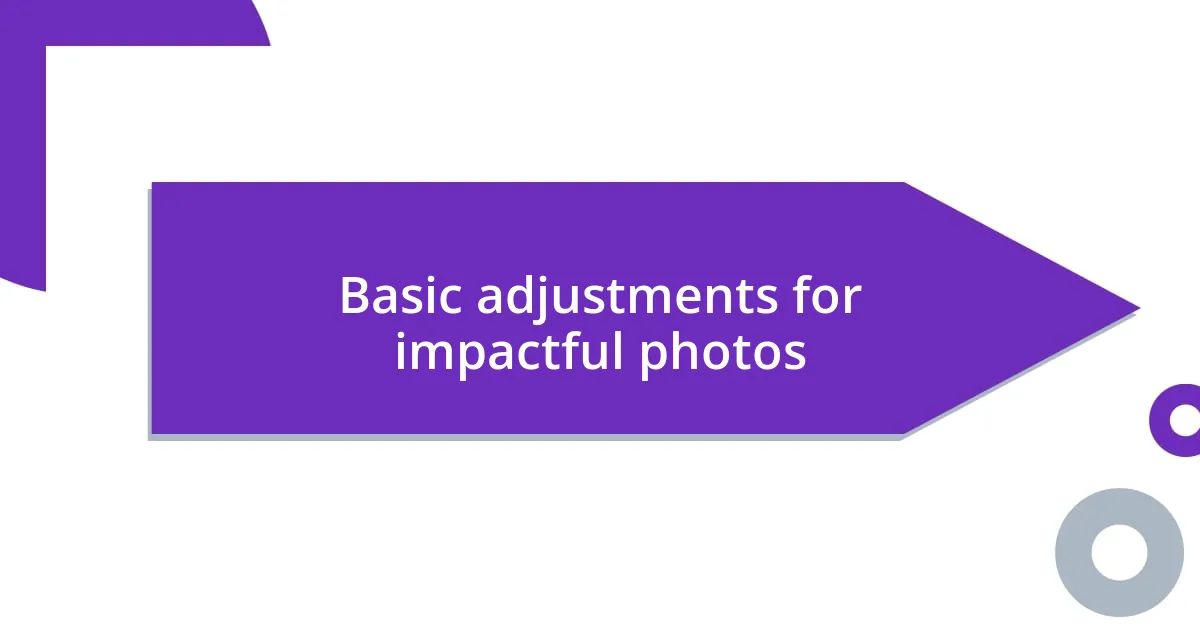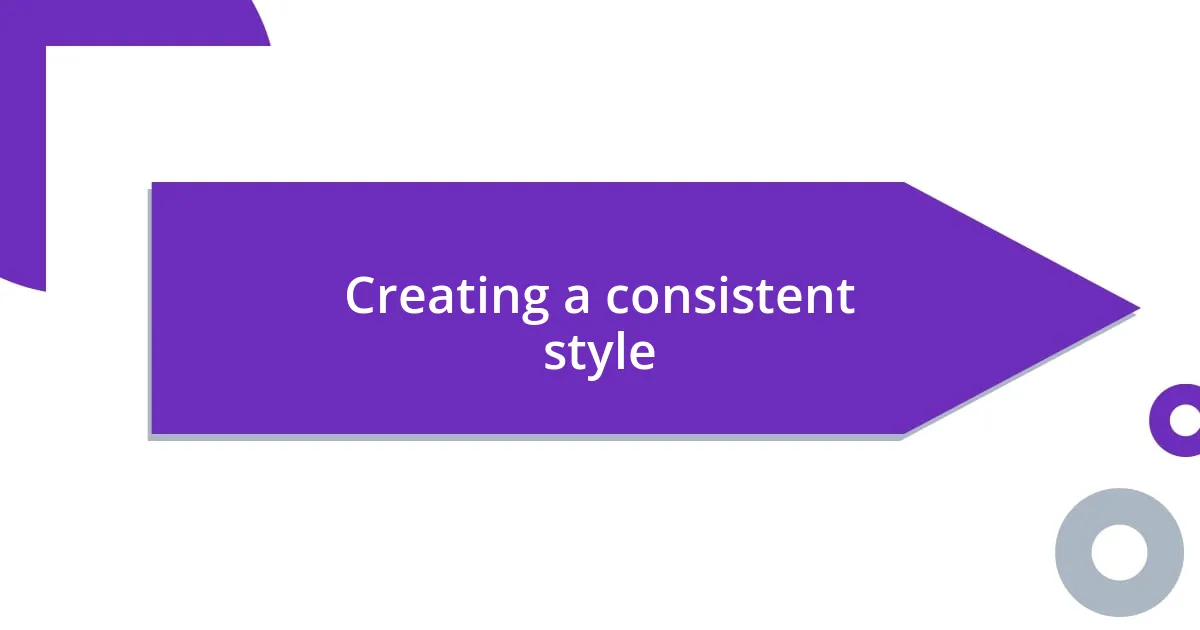Key takeaways:
- Street photography relies on patience and composition to capture impactful moments, focusing on emotions and storytelling.
- Choosing appropriate editing software is essential; consider user interface, features, compatibility, community resources, and price.
- Basic adjustments like exposure, contrast, and color changes significantly enhance the narrative and mood of street photos.
- Creating a consistent editing style through color palettes and cropping techniques helps in making your work recognizable and cohesive.

Understanding street photography techniques
Street photography thrives on the spontaneity of everyday life, which often means being ready to capture fleeting moments. I remember one afternoon wandering through a bustling market, camera in hand, feeling a mix of excitement and anticipation. That day taught me that patience is a vital technique; you must be prepared to wait for the right shot while remaining invisible to your subjects.
One key technique I’ve learned is the importance of composition. A well-framed photograph can transform a mundane scene into a powerful story. For instance, I often use leading lines to draw the viewer’s eye into the image. Have you ever noticed how a simple geometric element can change your perspective? It’s a small detail that, when done right, can evoke a sense of movement and depth.
Then there’s the art of capturing emotions. It’s all about being in tune with the atmosphere around you. One memorable shot was of an elderly man sitting on a park bench, his face lined with stories. I felt a rush as I realized the beauty in his solitude—a moment that spoke volumes without uttering a single word. What emotions do you want to evoke in your viewers? Understanding this can guide your approach and enhance the impact of your street photography.

Choosing the right editing software
Choosing the right editing software can make all the difference in refining your street photography. I recall my initial struggles sifting through apps that promised the world but left me feeling overwhelmed and underwhelmed at the same time. A well-chosen software should feel like an extension of your creative vision, providing the tools you need without imposing unnecessary complexity.
Here are some factors to consider when selecting your editing software:
- User Interface: Look for a clean and intuitive layout that allows for quick adjustments.
- Features: Ensure the software includes essential editing tools like cropping, color correction, and filters that resonate with your style.
- Compatibility: Check if it works seamlessly with your operating system and whether it supports the file formats you use.
- Community and Resources: Consider options with available tutorials or a community where you can share experiences and tips.
- Price: Find software that fits your budget, whether it’s a one-time purchase or subscription model.
In my experience, the right software not only enhances my work but also inspires me to experiment. I fondly remember discovering a particular editing program that instantly felt like home. It was like meeting a long-lost friend who understood my artistic intentions. The way I was able to fine-tune the colors in my street shots brought out the golden hues of a sunset against city buildings, making those moments even more impactful. That emotional connection to the software can truly elevate your editing process.

Basic adjustments for impactful photos
Basic adjustments are the backbone of impactful street photography. I often start with exposure. Balancing brightness can significantly enhance the mood of an image. For instance, I remember a rainy day when I had to adjust the exposure in post-processing. It transformed a dull shot into a captivating scene that highlighted the reflections on the pavement, creating a dramatic atmosphere.
Next, I focus on contrast. Increasing contrast can make the subject pop, separatiing it from the background. I once captured a vibrant mural in a crowded alley. By boosting contrast, the colors burst from the frame, giving life to the photo. Have you noticed how a little adjustment can evoke the essence of a moment? It’s fascinating how tweaking these settings can change the narrative of your image.
Finally, color adjustments play a crucial role. I often experiment with saturation and temperature to shape the story I want to convey. There was a time I shot a street performer under harsh lighting. Adjusting the color temperature to a warmer tone brought a sense of harmony and drew more attention to his expressive gestures. It’s these basic adjustments that breathe life into our photos and make them impactful.
| Adjustment | Impact |
|---|---|
| Exposure | Balances brightness, enhancing mood and clarity. |
| Contrast | Separates subjects from backgrounds, adds depth. |
| Color Adjustments | Shapes narrative and emotion through tone variations. |

Enhancing colors and contrast effectively
Enhancing colors and contrast effectively can truly transform street photography. One of my favorite techniques is adjusting saturation—adding a little boost can breathe life into an otherwise flat image. I remember a photo I took in a bustling market. The original colors felt muted and uninviting, but after a few tweaks, the vibrant reds and yellows of the fruits practically jumped out at me. Have you ever experienced that delightful moment when your photo suddenly feels alive?
Contrast adjustments also play a pivotal role in achieving impact. I often find that raising the contrast creates a striking interplay between light and shadow. I think back to a shot I captured at dusk, where a silhouette stood against an illuminated storefront. Enhancing the contrast made the details sharp and defined, highlighting the subject’s outlines while plunging the background into rich darkness. It’s amazing how such a small adjustment can shift the entire mood of a photograph.
Lastly, color grading is where I find myself really diving into creativity. It’s like painting with emotions. There was a time when I edited a street scene after a summer rain. I shifted the hues slightly toward cooler blues and greens, which evoked the freshness of the moment. This subtle change reminded viewers of that exhilarating feeling of stepping into a city after a downpour. I often ask myself—what mood do I want to convey? Exploring those choices in color has become a deeply personal part of my editing journey.

Implementing advanced editing techniques
When it comes to implementing advanced editing techniques, I often turn to selective editing to enhance specific areas in my street photos. For instance, I experimented with localized adjustments during one of my walks through a busy festival. I wanted to draw attention to a smiling child amidst a flurry of colorful stalls. By applying a vignette effect around the edges, the chaotic background blurred away, allowing her joyous expression to shine through more effectively. Have you ever noticed how focusing the viewer’s gaze can completely alter their experience of a photo?
Another advanced technique that I’ve come to appreciate is the use of layers and masks. Just the other day, while editing a sun-drenched street scene, I realized how important it was to isolate and enhance the details in the shadows without blowing out the highlights. By using masks to selectively brighten the shadowy corners, I could retain the warm vibes of the sunlight glowing on the pavement. It’s a reminder that sometimes, the magic lies in the subtleties.
Then there’s dodging and burning, which has become a game-changer for me. I recall editing a black-and-white shot of a gritty urban alley. By dodging (lightening) the areas where sunlight fell and burning (darkening) the shadows, I crafted a dramatic interplay that really captured the rawness of the scene. This technique made me realize how shadows and highlights can evoke emotions—such as solitude or intrigue—bringing a narrative flair to the photograph. Have you tried using these techniques to weave emotion into your work? It’s an exhilarating process that can turn a simple snap into a storytelling masterpiece.

Creating a consistent style
Creating a consistent editing style is essential for making your street photography recognizable. I’ve found that developing a unique color palette contributes significantly to this uniformity. For example, during my last trip to New Orleans, I introduced a warm, golden tone to all my images, which gave them a sun-kissed glow, perfectly complementing the city’s vibrancy. Have you ever noticed how certain colors can evoke specific feelings? It’s fascinating how a simple shift in hue can encapsulate the essence of a place.
Additionally, using similar cropping techniques across my photos helps maintain a cohesive look. On one occasion, while capturing street musicians, I decided to consistently frame them within a square format. This choice not only highlighted the musicians but also aligned with my artistic vision, creating a gallery that feels united rather than a random collection. When I look back at that body of work, it sparks nostalgia—almost as if I can hear the music again. Doesn’t it feel satisfying to see a series of images tell a cohesive story?
Lastly, I often revisit my own previous edits to understand what worked and what didn’t. I recall a set of black-and-white street portraits where I initially overexposed some details. By analyzing the edits, I realized that I preferred keeping textures prominent. Since then, I’ve made it a point to maintain clarity in textures for all similar photos. I wonder, how often do you reflect on your earlier work? It’s a glimpse into your evolution as a photographer and can provide invaluable lessons for enhancing your signature style.

Final review and export settings
During the final review of my street photos, I take a moment to step back and view the image as a whole. Recently, while editing a striking shot of a late-night street vendor illuminated by neon lights, I found that some small distractions around the edges drew my eye away from the focal point. By cropping it just slightly, I was able to create a more intimate view of the vendor’s candid smile. Have you ever felt that a little tweak can transform the entire vibe of a photo?
Export settings are just as crucial, and I’ve learned through experience that the right choice can enhance the clarity and quality of the final image. For example, when preparing for an online gallery, I typically export in sRGB color space for consistency across different screens. This little detail ensures that my vibrant tones remain true to life. It’s those kinds of decisions that make a difference in how viewers perceive your work. What settings have you found to elevate your own images during the export process?
Lastly, I’ve developed a habit of exporting multiple versions of my photos, especially for social media and print. Some time ago, while preparing for a portfolio submission, I realized that having a higher resolution version allowed me to showcase intricate details in a couple of my favorite shots. It’s important to tailor your exports to your audience—do you strive to provide options for different platforms? I’ve found this simple approach not only expands my reach but also allows each photo to shine in its intended context.













